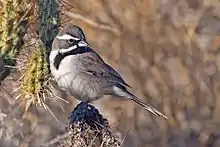| Black-throated sparrow | |
|---|---|
 | |
 | |
| Scientific classification | |
| Domain: | Eukaryota |
| Kingdom: | Animalia |
| Phylum: | Chordata |
| Class: | Aves |
| Order: | Passeriformes |
| Family: | Passerellidae |
| Genus: | Amphispiza Coues, 1874 |
| Species: | A. bilineata |
| Binomial name | |
| Amphispiza bilineata (Cassin, 1850) | |
 | |
The black-throated sparrow (Amphispiza bilineata) is a small New World sparrow primarily found in the southwestern United States and Mexico. It is the only member of the genus Amphispiza; the five-striped sparrow, formerly also classified in Amphispiza, is now thought to be in the monotypic genus Amphispizopsis.[2]
It is sometimes referred to as the desert sparrow, due to its preferred habitat of arid desert hillsides and scrub. This name usually refers to the desert sparrow of Africa and Asia.
Description
Measurements:[3]
- Length: 4.7–5.5 in (12–14 cm)
- Weight: 0.4–0.5 oz (11–14 g)
- Wingspan: 7.7 inches (20 cm)
The black-throated sparrow is pale gray above, with a distinctive black and white head pattern. Immature birds are similar but lack a black throat. Its call is high and bell-like, and its song is a fairly simple, mechanical tinkling. It feeds primarily on insects and seeds, and travels in small groups, though larger groups may accumulate around sources of water in the desert.
It has a loose nest of grass twigs and plant fibers carefully hidden in brush 6–18 inches (15–46 cm) above the ground. Three or four white or pale blue eggs are laid.
Diet
The black-throated sparrow's diet consists of bugs during the mating season and seeds during the non-breeding season. They mainly forage one the ground around bushes and cacti and sometimes glean food from leaves and twigs.
References
- ↑ BirdLife International (2018). "Amphispiza bilineata". IUCN Red List of Threatened Species. 2018: e.T22721194A132008021. doi:10.2305/IUCN.UK.2018-2.RLTS.T22721194A132008021.en. Retrieved 12 November 2021.
- ↑ "Taxonomic Updates – IOC World Bird List". Retrieved 14 July 2021.
- ↑ "Black-throated Sparrow Identification, All About Birds, Cornell Lab of Ornithology". allaboutbirds.org. Retrieved 29 September 2020.
- David Allen Sibley, The Sibley Field Guide to Birds of Western North America. ISBN 0-679-45121-8
External links
- Black-throated sparrow – Amphispiza bilineata – USGS Patuxent Bird Identification InfoCenter
- Black-throated sparrow species account – Cornell Lab of Ornithology
